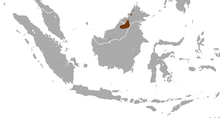Plain roller
| Plain roller | ||||||||||||
|---|---|---|---|---|---|---|---|---|---|---|---|---|

Drawing of a roller by Joseph Smit from the first description published in the Proceedings of the Zoological Society of London in 1892 |
||||||||||||
| Systematics | ||||||||||||
|
||||||||||||
| Scientific name of the genus | ||||||||||||
| Diplogale | ||||||||||||
| Thomas , 1912 | ||||||||||||
| Scientific name of the species | ||||||||||||
| Diplogale hosei | ||||||||||||
| (Thomas, 1892) |
The Hose's Palm Civet ( Diplogale hosei , synonym Hemigale hosei ) is a predatory species from the family of civets (Viverridae). It is endemic to northern Borneo in Sarawak , Brunei and Sabah and is one of the rarest and least well-known members of his family.
features
It is similar to the closely related ribbon roller , but in contrast to this it is not patterned, but colored in a single brown or blackish color. The underside is lighter, mostly yellow-gray or reddish. The feet and tail are black. Its physique is slender and elongated, the pointed muzzle is striking. There are some white spots on the sides of the muzzle and above and below the eyes and on the cheeks. The tail is black. The inside of the front and rear legs are gray. The front and rear paws have five toes, some of which are webbed together. Plain rollers reach a head body length of 47 to 54 centimeters and a tail length of 30 to 33.5 centimeters. The rear foot length is 7.4 to 8.1 centimeters and the ears are about 3.6 cm long. The vibrissa are remarkably long (more than 15 cm). The weight of the sizing roller is 1 to 3 kg. The nasal mirror is bilobed, the nostrils open to the side. The females have a pair of teats.
The tooth formula is: I3 / 3, C1 / 1, P 4/4, M 2/2.
Habitat and way of life
Plain rollers occur in primary rainforests and mountain forests dominated by broad-leaved plants at altitudes of 450 to 1700 meters. Little is known about the way of life. Plain rollers presumably live mainly on the ground and are probably nocturnal like most crawling cats. From the stomach contents of the specimens found, one concludes that worms and insects are the main components of the diet. From the webbed feet between their toes it is concluded that they also hunt for frogs in mountain streams . Nothing is known about the reproductive behavior of the scooter.
Danger
Only a few specimens of this animal have been found so far, so their current population size and degree of endangerment are unknown. The scooter is found in a few protected areas, in Mount Kinabalu National Park and in the Kinabatangan Wildlife Sanctuary in Sabah and in Ulu-Temburong National Park in Brunei. The IUCN estimates the population of the species as endangered.
supporting documents
- ↑ a b c d Don E. Wilson , Russell A. Mittermeier : Handbook of the Mammals of the World - Volume 1 Carnivores. Lynx Editions, 2009, ISBN 978-84-96553-49-1 . Page 232.
- ↑ Diplogale hosei in the Red List of Threatened Species of the IUCN 2006. Posted by: Mustelid Specialist Group, 1996. Retrieved on 11 May, 2006.
